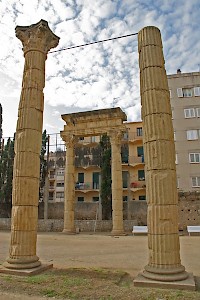Tarraco (Tarragona)
Q1501940Tarraco: capital of a Roman province, Hispania Tarraconensis; modern Tarragona.

Built on terraces on a 160 meter high rock, and supplied from a natural harbor, Tarraco was a difficult city to take. The Romans, who occupied the Iberian town (or Phoenician colony?) during the Second Punic War (218-202), fortified it even more. Their commanders Publius and Gnaeus Cornelius Scipio erected a 10 meter high wall, which is preserved over a distance of more than a kilometer - about a quarter of the original length.
The wall was constructed on a foundation of large ("cyclopean") natural stones and consists of two parallel walls, 4 meters apart, of bossed ashlars. The core was stuffed with stones, earth, and adobe. Every ten meters, transversal braces were added. Bricks were used to close the wall. Three towers survive, which used to be famous: Pliny the Elder mentions them in his Natural History.

Tarraco was Rome's base for further operations in Hispania: not only in the Second Punic War, but also in the wars against the Iberians, Celtiberians, and Lusitanians. Thus it became a provincial capital, first of Hispania Citerior, later of Hispania Tarraconensis, which means that there was a praetorium or governor's palace. In 45 BCE, Julius Caesar gave the city the rights of a colonia; from now on, its full official name was Colonia Julia Urbs Triumphalis Tarraco.
After 27 BCE, the emperor Augustus used Tarraco as base for his operations against the Cantabrians, one of the largest wars in Roman history, involving no less than nine legions (I Germanica, II Augusta, IIII Macedonica, V Alaudae, VI Victrix, VIIII Hispana, X Gemina, XX Valeria Victrix, and another unit, perhaps VIII Augusta). In these years, the Romans also built the Via Augusta, which connected Tarraco to Emporiae in the northeast to Corduba, Hispalis, and Gades in the southwest. The city also boasted a temple of Augustus.note

The monument known as "the tower of the Scipiones" is built along the Via Augusta, about eight kilometers east of Tarraco. It is not really the tomb of the Roman generals, although they were defeated and killed in Spain (in 212 BCE). In fact, the monument dates back to the first half of the first century CE. It was well visible from the coast and must have been really impressive, especially since it was, back then, taller than today.
It consists of a base, on which a tower was erected. In the lower part of the tower, two human figures can be discerned, which were in the Middle Ages identified with the Roman commanders. In fact, they represent Attis, an oriental god related to the funeral cult.
Being the capital of the largest Spanish province, it was inevitable that Tarraco became a very rich town, full of monuments, like a circus, an aqueduct (first century CE), and an amphitheater. Its splendor is best appreciated in the Museu Nacional Arqueològic de Tarragona, which has a beautiful collection, including the mosaics that were excavated in the wealthy urban dwellings in the area known as the Pedrera del Port. One of these, discovered in 1955 in a villa at La Pineda near the town of Vila-seca, is no less than 6¼ meters long and 4½ meters wide, and shows all kinds of sea creatures. It was made in the third century.
 Tarraco, Aqueduct |
 Tarraco, Wall |
 Tarraco, Theater |
 Tarrago, Theater |
 Tarraco, Tower of the Scipiones, detail |
 Tarraco, Mosaic with fish |
 Tarraco, Wall painting with a hunting scene |
 Tarraco, Medusa mosaic |
A famous citizen was Lucius Licinius Sura, a courtier of the emperor Trajan, for whom the Arch of Bera was erected.
After the mid-third century, Tarraco declined. In the 250s, the city was sacked by a band of Franks.note Other towns, such as Barcino (Barcelona) became more important. In 476, the Visigoths captured the city, which remained the see of bishop.